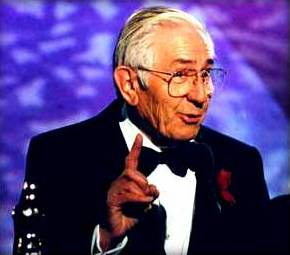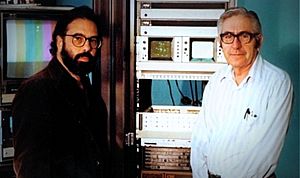Petro Vlahos facts for kids
Quick facts for kids
Petro Vlahos
|
|
|---|---|

Vlahos accepting his second Oscar, c. 1993
|
|
| Born | August 20, 1916 Raton, New Mexico, U.S.
|
| Died | February 10, 2013 (aged 96) Los Angeles, California, U.S.
|
| Alma mater | University of California at Berkeley |
| Occupation | Special effects engineer |
Petro Vlahos (Greek: Πέτρος Βλάχος; August 20, 1916 – February 10, 2013) was an amazing American engineer and inventor. He made huge contributions to how movies and TV shows are made. He's especially famous for inventing the Ultimatte process. This made the "bluescreen" technique, also known as chroma key, much better. Because of his brilliant work, he won many Oscars and an Emmy Award.
Contents
Early Life and Education
Petro Vlahos was born in Raton, New Mexico, in 1916. His parents were immigrants from Greece. From a young age, he was very good with electronics and loved ham radio. In 1941, he earned his engineering degree. He studied at the University of California at Berkeley.
During World War II, he worked as a designer for Douglas Aircraft. Later, he became a radar engineer at Bell Laboratories. After the war, he moved to Hollywood. There, he started working for MGM, a big movie studio.
Making Movie Magic: Hollywood Career
The special effects we see in movies today often use techniques Petro Vlahos developed. He wasn't the first to use "blue-screen" technology. That idea started with Larry Butler for the 1940 film The Thief of Bagdad. However, Vlahos made the process much more realistic and scientific.
Improving Bluescreen Technology
Petro Vlahos created a system called the sodium vapor process. He first used it for films like The Parent Trap and The Absent-Minded Professor. Later, he used it for the Disney musical Mary Poppins (1964). This work even won him an Oscar!
For the movie Ben-Hur, he improved the color-difference bluescreen process. This allowed for amazing visual effects in films. He found a way to reduce the problems that earlier methods had. Vlahos' big breakthrough was a complex lab process. It involved separating the blue, green, and red parts of each film frame. Then, he would combine them back in a specific order.
He also introduced the use of motion control cameras during bluescreen work. This made the effects even smoother. He called his advanced invention the color-difference travelling matte scheme.

Founding Ultimatte Corporation
In 1976, Petro Vlahos started the Ultimatte Corporation. He founded it with his son, Paul Vlahos, in Chatsworth, California. Their first Ultimatte devices were analog "black boxes." Over time, these became advanced digital hardware and computer software products.
Impact on Blockbuster Films
When science fiction and fantasy movies became very popular, Vlahos' techniques became super important. They were essential for films like the Star Wars trilogy. His pioneering techniques were refined and used in many blockbuster movies of the 1990s. A great example is Titanic (1997). Thanks to his work, dangerous, expensive, or difficult scenes could finally be filmed safely.
Petro Vlahos held more than 35 patents for his film-related inventions.
Awards and Recognition
Petro Vlahos was a member of the Academy’s original Motion Picture Research Council. The Academy of Motion Picture Arts and Sciences honored him many times. His first award was a Scientific and Technical Award in 1960. This was for a device that showed camera flicker.
He won his first Oscar in 1964. This was for his "conception and perfection of techniques for color traveling matte composite cinematography." This means he was recognized for inventing and perfecting the methods for combining different film parts using color.
In 1978, Petro won an Emmy Award for his Ultimatte Compositing Technology. This award recognized his work in TV.
The Academy of Motion Picture Arts and Sciences gave him a Medal of Commendation in 1992. In 1993, he received the Gordon E. Sawyer Award, which was his second Oscar.
In 1995, he shared a third Oscar (Academy Scientific and Technical Award) with his son, Paul. This was for the improvements made to blue-screen technology by Ultimatte Corporation.

